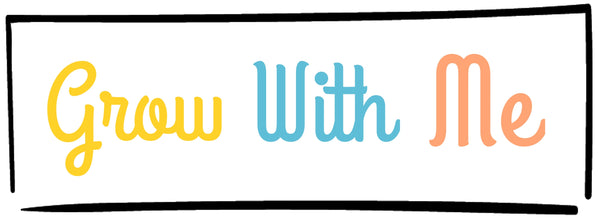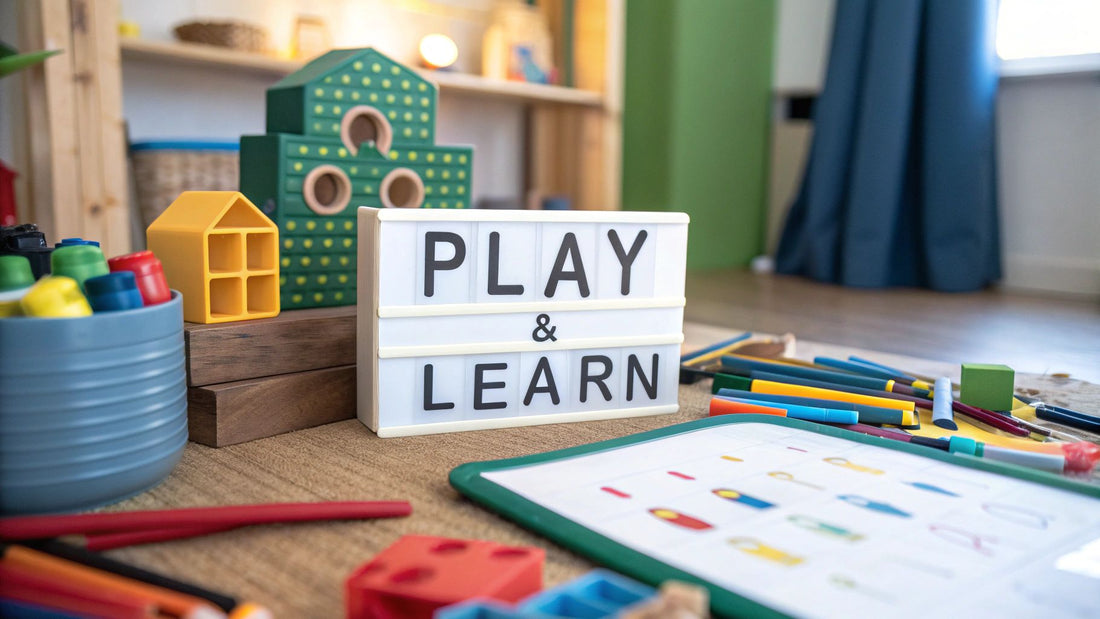
Choosing Learning Toys for 2-3 Year Olds
Share
The best learning toys for 2-3 year olds are the simple, open-ended ones. Think building blocks, puzzles, and dress-up clothes. These aren't just distractions; they are the fundamental tools toddlers use to figure out their world and build crucial life skills.
A Toddler's Brain is Under Construction
Welcome to the wonderfully chaotic world of toddlerhood! This isn't just a phase of tantrums and tiptoes; it's a period of explosive brain growth. Between the ages of two and three, your little one is laying the foundation for all future learning.
Imagine your toddler as the chief architect of a massive skyscraper. Play is their work, and the right toys are the high-quality materials they need to build everything from language and problem-solving to social skills. When you understand the why behind their play, you start to see it in a whole new light.
Key Areas of Development
This stage is about so much more than just learning colours and shapes. It’s about forging connections between ideas and making sense of a very big world. This all happens across a few key areas at once.
- Cognitive Growth: Toddlers are starting to grasp cause-and-effect (if I push this, it falls over!). They solve simple problems, like fitting a square block into the square hole, and their memory starts to kick in. Their vocabulary often leaps from around 50 words to over 200.
- Motor Skills: You'll see their fine motor control sharpen as they stack blocks higher, carefully turn the pages of a book, and hold a crayon with a bit more purpose. At the same time, their gross motor skills are also taking off, leading to better running, jumping, and climbing.
- Social-Emotional Development: This is when "parallel play" often starts—they'll happily play next to another child, even if they aren't playing with them. They’re also beginning to understand feelings, show empathy, and dive into imaginative pretend play, which is absolutely vital for social learning.
Play is often called the "work of childhood," and for good reason. It’s how toddlers test theories, practise new skills, and process everything they see and hear. The right toys make this important work possible.
This diagram shows how these different areas of development are all happening at the same time.
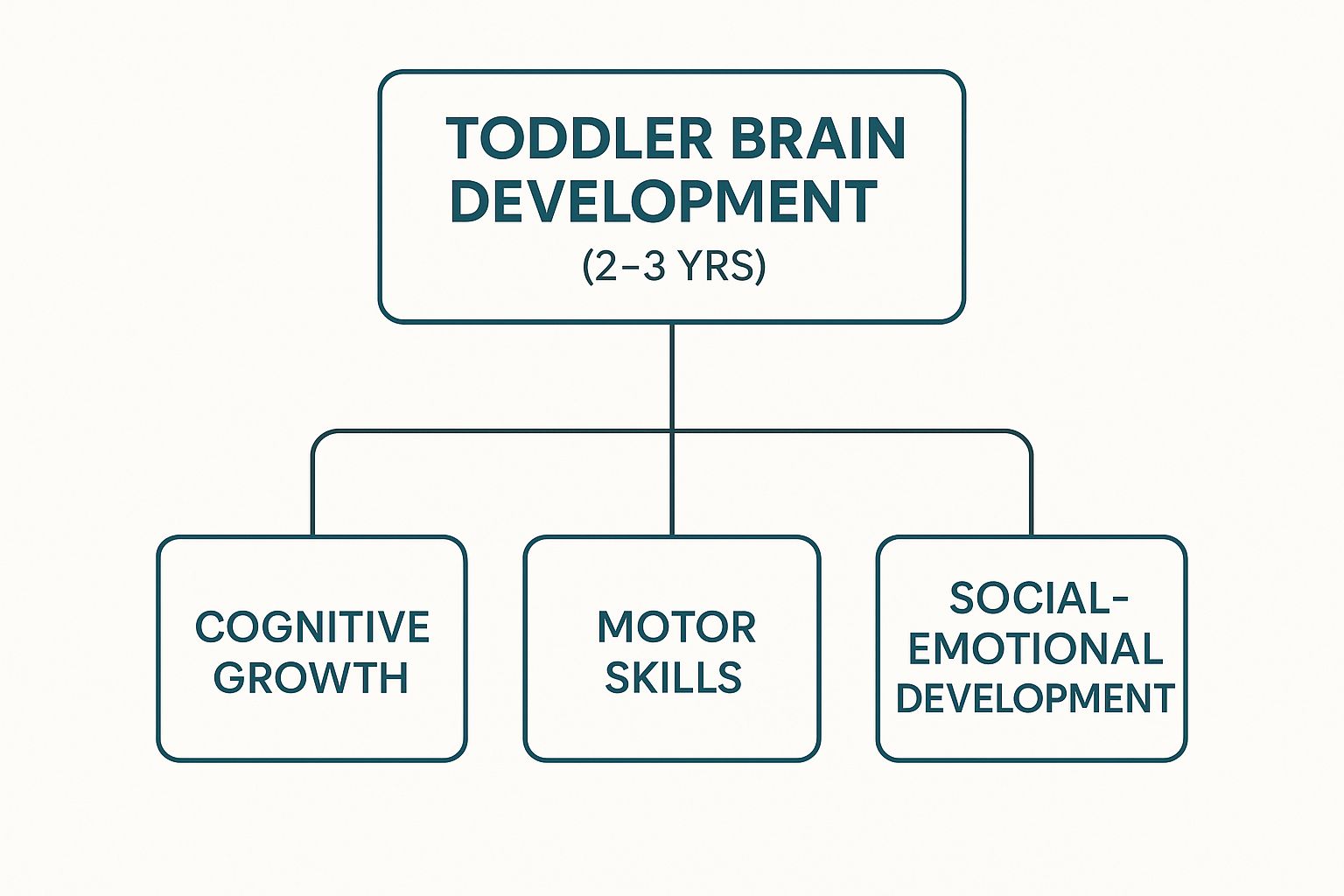
As the visual shows, these cognitive, motor, and social-emotional skills are like separate pillars, but they all work together to support your child's overall growth.
Parents clearly recognise how important this stage is. The UK market for educational toys brought in a massive USD 4.05 billion in 2023 and is expected to hit USD 6.58 billion by 2030. Building sets and role-play toys are especially popular, showing that parents are keen to invest in these key developmental tools. You can discover more insights about the educational toys market to see the trends.
How to Select the Right Toys for Your Toddler
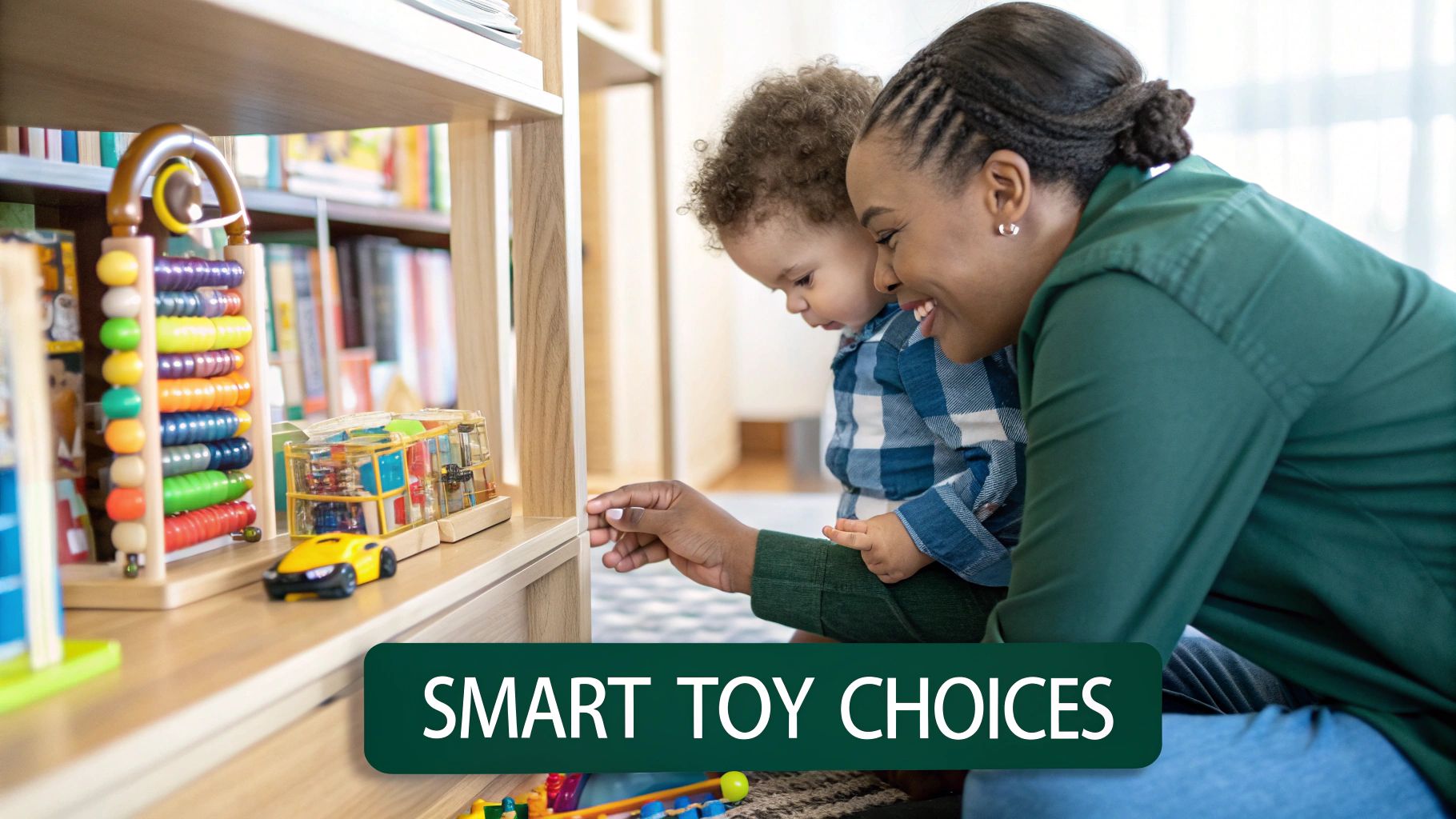
Walking into a toy shop can feel a bit overwhelming, can't it? With a sea of brightly coloured boxes all shouting for your attention, it's hard to know where to start. The secret is to look past the flashy packaging and think about a few simple things that make a toy truly brilliant for a 2-3 year old.
Think of it less as buying an object and more as choosing a tool for their development. The very best learning toys for this age group have three things in common: they're safe, they're built to last, and they have a real purpose.
Core Qualities of a Great Toddler Toy
When you’re weighing up whether to buy a new toy, keep these simple checks in your back pocket. If a toy ticks all three boxes, it’s probably a fantastic addition to your child’s playroom.
-
Safety First: This is non-negotiable. Toddler toys must be made from non-toxic materials and be tough enough to survive being dropped, thrown, and even chewed on. Check for solid construction and make sure there are no small bits that could break off and become a choking hazard.
-
Longevity and Versatility: Can the toy be used in more than one way? The best toys are the ones that grow with your child. Think about a simple set of wooden blocks. At two, they’re perfect for basic stacking. By three or four, those same blocks are being used to build incredible castles and sprawling cities.
-
Developmental Purpose: A truly great toy should challenge your child in a fun, gentle way. It needs to get them thinking, creating, and figuring things out for themselves.
Following these principles is a great starting point. If you want to dive a little deeper, our guide on the benefits of developmental toys for toddlers offers some more fantastic insights.
Matching Toys to Specific Skills
Knowing how a toy helps makes choosing one so much easier. Instead of just grabbing a generic "learning toy," you can pick something that directly supports an area your child is currently working on. It could be their fine motor skills or their budding imagination.
The most powerful toys are often the simplest. They don't have batteries or flashy lights; instead, they require your child to bring their own imagination and curiosity to the table.
This simple shift in perspective helps you see toys not just as entertainment, but as targeted tools for growth. The table below is designed to be a practical guide, connecting key developmental areas with the kinds of toys that help them flourish. It’s all about helping you choose with confidence, knowing each toy has a clear purpose in your child’s learning journey.
Matching Learning Toys to Toddler Skills
This quick guide will help you connect the dots between what your child is learning to do and the types of toys that can give them the best support.
| Developmental Skill Area | What It Looks Like at Age 2-3 | Ideal Toy Categories | Specific Toy Examples |
|---|---|---|---|
| Fine Motor Skills | Stacking blocks, turning pages, using a fork | Puzzles, Building Blocks, Art Supplies | Chunky wooden puzzles, Lego Duplo |
| Problem-Solving | Trying different ways to make something work, sorting by colour | Shape Sorters, Puzzles | Shape sorter cubes, simple jigsaws |
| Language & Communication | Using 2-3 word sentences, engaging in pretend conversations | Pretend Play Sets, Books | Toy kitchen, dolls, picture books |
| Social-Emotional Growth | Imitating others, showing empathy, expressing feelings | Role-Play Sets, Dolls | Dress-up clothes, doctor’s kits |
By choosing toys with a purpose, you're not just filling a toy box—you're providing the building blocks for your child's next big developmental leap.
The Most Effective Types of Learning Toys
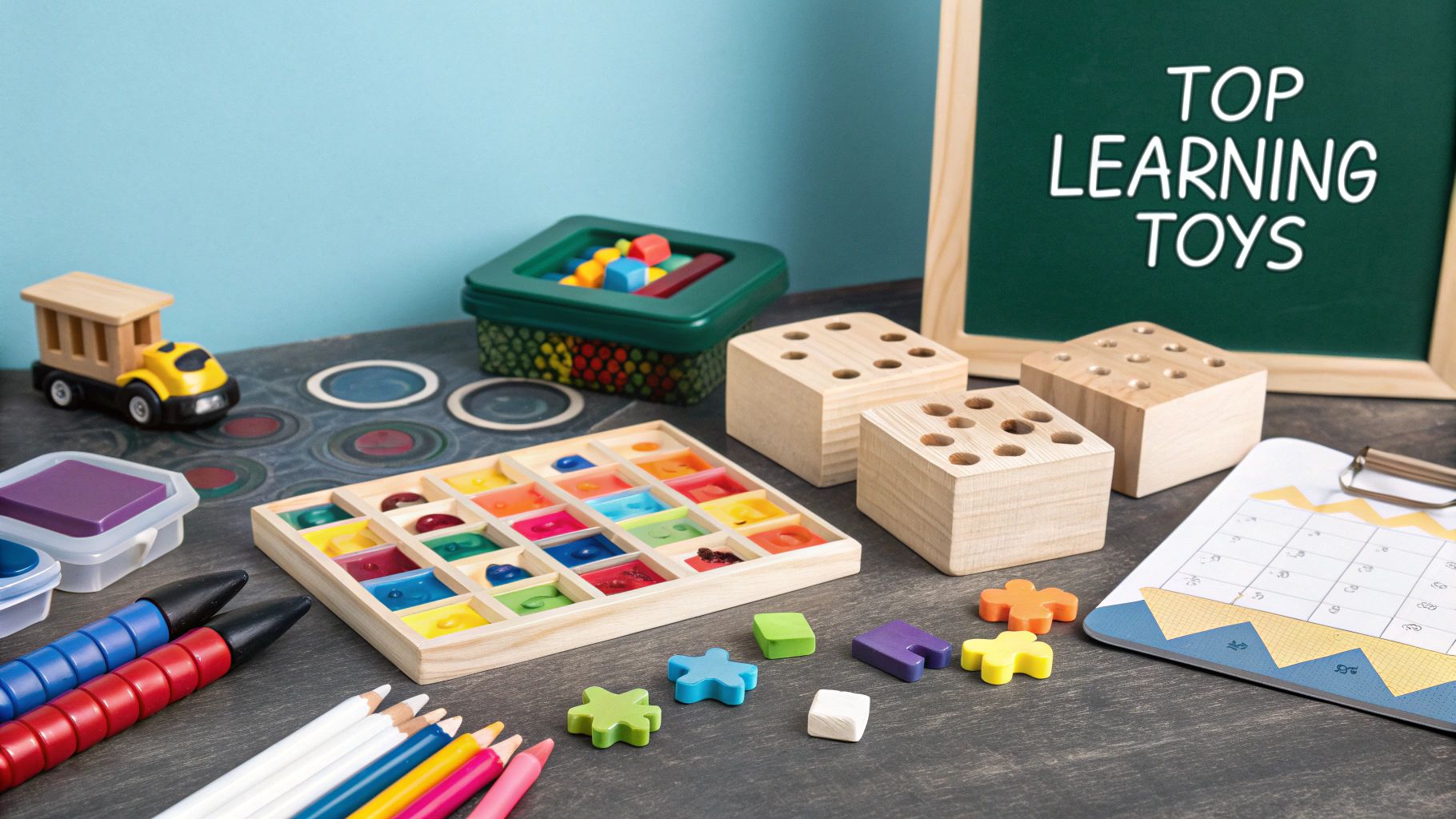
Now that we know what makes a good toy tick, let's dive into the categories that really pack a developmental punch. These are the absolute must-haves for any two to three-year-old's toy box, each acting as a powerful tool for honing specific skills.
Think of these less as individual items and more as a well-rounded toolkit for your child’s incredible growth spurt. By offering a mix of these toys, you create a rich environment that nurtures everything from logical thinking to creative expression.
Puzzles and Shape Sorters
Puzzles and shape sorters are the classic brain-builders for this age, and for good reason. They are essentially your toddler’s first lesson in logic and problem-solving. When a child tries to jam a star-shaped block into a square hole, they're not just playing—they're running a tiny science experiment. They test a hypothesis, see the result, and try again.
This simple back-and-forth teaches some massive cognitive skills:
- Shape Recognition: The fundamental difference between a circle, a square, and a triangle clicks into place.
- Spatial Awareness: They start to grasp how objects relate to each other and fit together in the world.
- Persistence: They learn that if one approach doesn’t work, it's time to try another.
Let's not forget what these toys do for fine motor skills. The focus it takes to grasp a chunky puzzle piece and carefully guide it home is a fantastic workout for their developing hand-eye coordination.
Blocks and Construction Sets
Blocks might just be the most versatile learning toys for 2-3 year olds on the planet. A simple set of wooden blocks can become a towering skyscraper, a speeding train, or a fence for their favourite farm animals. They are the ultimate open-ended toy, where the only limit is a child's bursting imagination.
As your toddler stacks, builds, and—of course—gleefully knocks it all down, they are absorbing foundational lessons in physics. They're getting a real, hands-on feel for balance, gravity, and stability. This kind of play directly builds the spatial reasoning skills they'll need for maths and science later on.
Blocks don't come with instructions; they come with possibilities. They invite children to become creators, architects, and storytellers, building not just towers but also confidence and creativity.
What’s brilliant is how these toys grow right alongside your child. A two-year-old might be thrilled to just stack a few blocks high, while a three-year-old could be busy creating elaborate, sprawling cities.
Art Supplies and Creative Tools
Scribbling with a chunky crayon or squishing a blob of playdough is so much more than just making a mess (though there will be some of that!). Art gives toddlers a crucial outlet for self-expression, especially when they don’t yet have all the words to share their big feelings and even bigger ideas.
Getting stuck in with art materials helps develop:
- Fine Motor Control: That pincer grasp they use to hold a crayon or paintbrush is strengthening all the tiny muscles in their hands.
- Sensory Exploration: The cool, smooth feel of finger paint or the squishy texture of dough provides a wealth of sensory input.
- Creativity and Imagination: With art, there is no "right way" to do things, which frees them up to experiment and think originally.
Many of these materials, particularly those made from natural, non-toxic ingredients, fit beautifully with the principles of Montessori learning. If that philosophy sparks your interest, you can explore our detailed guide to the best Montessori toys for toddlers for more inspiration.
Pretend Play Sets
This is where your toddler’s social and emotional skills really begin to sparkle. A toy kitchen, a doctor's kit, or a simple box of dress-up clothes lets them act out real-world situations, make sense of their experiences, and explore different roles in a safe, fun way.
When they pour you an imaginary cup of tea or carefully "fix" a teddy bear's sore leg, they are practising empathy, communication, and teamwork. This kind of play is an absolute powerhouse for language development as they narrate their stories and create imaginary conversations. It’s their very first step in seeing the world through someone else's eyes—a true cornerstone of emotional intelligence.
Eco-Friendly and Tech-Smart Toy Trends
https://www.youtube.com/embed/ALuDnVPeMSI
The toy landscape is definitely changing. It’s clear that parents are looking for smarter, more thoughtful options for their families, and two major trends are really leading the charge: a big shift towards sustainable, eco-friendly toys and a much more careful integration of technology into playtime.
These aren't just passing fads. They reflect a growing desire for toys that are not only brilliant for a child’s development but also a bit kinder to our planet. More and more, parents are choosing items that line up with their own values around safety, durability, and environmental responsibility.
The Rise of Sustainable Play
These days, what a toy is made of really matters. There’s a clear preference for natural, sustainable materials like wood from responsibly managed forests, non-toxic paints, and even plastics made from recycled materials. This isn’t just about being "green"; it’s about choosing toys that feel safer, last longer, and, let's be honest, often look more beautiful.
This shift is having a huge impact on the market. In fact, the UK baby toys market, which includes learning toys for 2-3 year olds, was valued at around USD 821.5 million in 2024 and is expected to nearly double by 2035. A key reason for this boom is the growing demand for high-quality, eco-friendly products. You can see how sustainability is shaping the market for yourself.
Choosing an eco-friendly toy is a quiet lesson in itself. It shows a child that we should care for the things we own and the world we live in, teaching a valuable lesson long before they can say the word "sustainability."
There’s a timeless appeal to wooden blocks, organic cotton dolls, and recycled plastic playsets that you just don't get with throwaway plastic toys. They connect children to natural textures and encourage a different kind of thoughtful, lasting play.
Smarter Tech Toys for Toddlers
Technology in the playroom can be a bit of a minefield. Many parents are rightly concerned about screen time, but it's important to realise that not all tech toys are created equal. The trick is to spot the difference between passive screen-gazing and genuinely interactive, educational toys that get your little one actively involved.
The best smart tech toys are designed to engage a child's mind directly. Think of toys that introduce the basics of coding through simple, screen-free robots, or interactive books that sound out letters and words when a child points to them.
These kinds of tools are designed to:
- Encourage active problem-solving instead of just passive watching.
- Introduce foundational STEM concepts in a playful, age-appropriate way.
- Provide immediate, helpful feedback that guides the learning process.
The best tech-smart toys act as a partner in play. They respond to what a child does and spark their curiosity to discover more. They aren’t here to replace traditional play, but to add another valuable layer to a child's developmental toolkit.
Unlocking Learning Potential Beyond the Toy
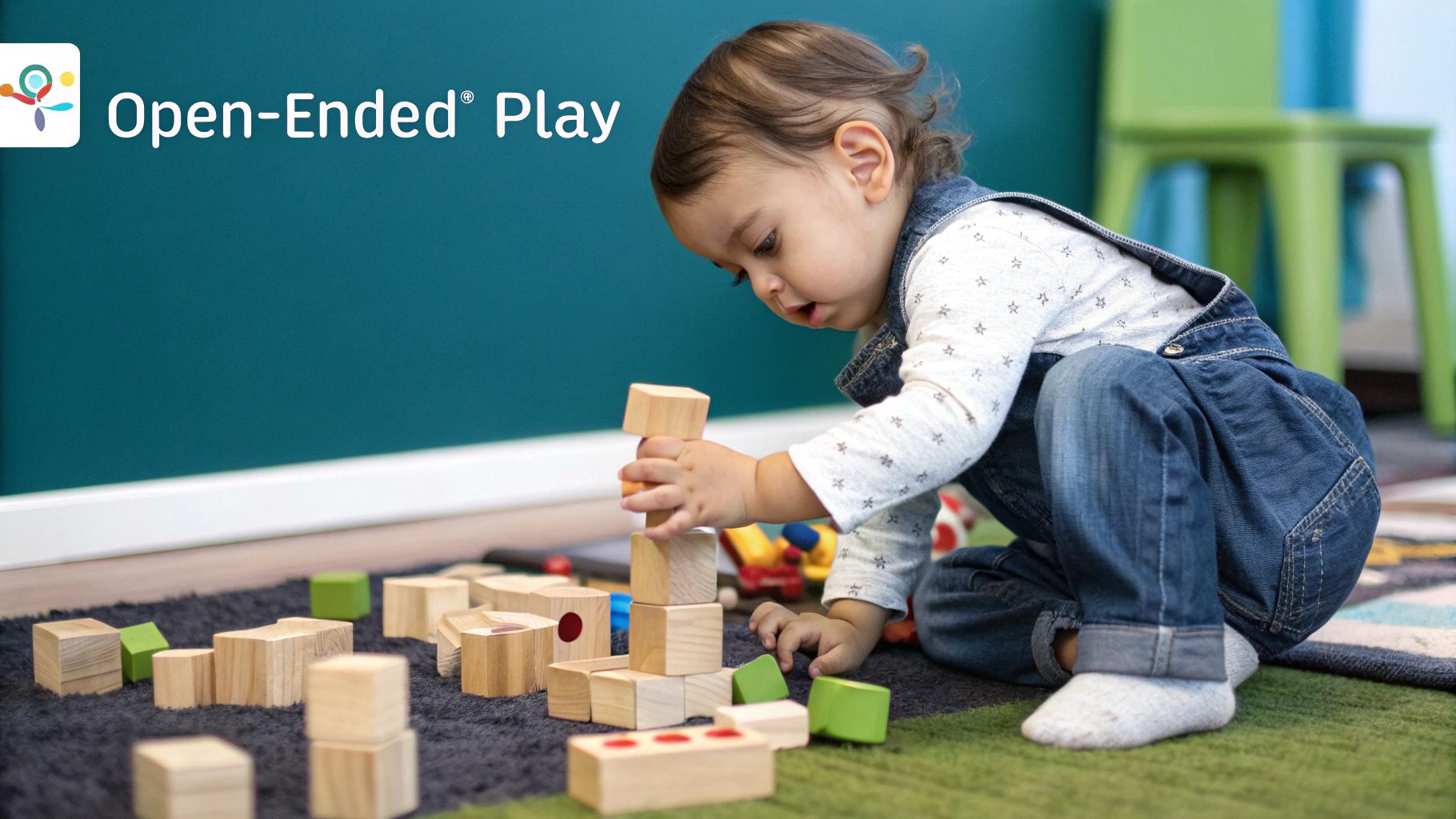
Even the most wonderful toy is only as good as the play it inspires. Just imagine a brilliant set of building blocks left gathering dust in a basket—all that potential is just sitting there, unused. The real magic isn't just in the toy itself, but in the environment you create to spark curiosity and encourage your little one to dive deep into play.
This doesn't mean you need a massive, dedicated playroom overflowing with toys. In fact, for toddlers, less is almost always more. Too many choices can be overwhelming, but a few simple, intentional strategies can turn your home into the perfect place for them to learn and grow.
The Power of Toy Rotation
Ever noticed how a toy that's been buried at the bottom of the box for weeks suddenly becomes the most fascinating thing in the room? That’s the simple brilliance of toy rotation. The idea is to keep just a small selection of toys out at any one time and store the rest away.
Then, every week or two, you simply swap them out. It’s a game-changer for a few reasons:
- It Prevents Overwhelm: A calmer, less cluttered space makes it so much easier for a toddler to focus.
- It Fosters Deeper Play: With fewer options, children spend more time with each toy, discovering all the different things they can do with it.
- It Keeps Things Fresh: Old toys feel brand new again! This keeps your child engaged without you having to constantly buy new things.
This simple routine ensures your carefully chosen learning toys for 2-3 year olds truly get the attention they deserve.
Think of yourself less as a provider of toys and more as a "play architect." By thoughtfully setting up their space and, most importantly, joining in, you're building the foundation for real learning and connection.
Encouraging Open-Ended Exploration
The most valuable kind of play is often "open-ended"—where there's no single 'right' way to do things. A colouring book has a clear goal: stay inside the lines. But a blank piece of paper and some crayons? The possibilities are endless. That's where creativity really takes flight.
You can nurture this by asking open questions that spark their imagination instead of testing what they know. So, rather than asking, "Is that a red block?" you could try, "I wonder what we could build with these blocks?" This tiny shift in language invites them to take the lead, boosting their confidence and creative thinking.
Exploring different textures and materials is another fantastic way to ignite their curiosity. For more brilliant inspiration, check out our guide on setting up engaging sensory play for toddlers. These ideas help turn simple playtime into a powerful engine for discovery.
Common Questions About Toddler Learning Toys
When you're trying to choose the right toys for your little one, it's natural for a few questions to pop up. Let's walk through some of the most common ones parents ask about learning toys for 2 to 3-year-olds.
How Many Toys Does My Toddler Actually Need?
It’s so easy to fall into the trap of thinking that more toys will lead to more learning, but it’s often the other way around. My advice? Always choose quality over quantity.
A carefully chosen handful of versatile, open-ended toys will do so much more for your child’s development than a room cluttered with flashy gadgets that only do one thing. A good set of building blocks, a few chunky puzzles, some basic art supplies, and a couple of bits for pretend play are really all you need to get started.
A toy rotation system is an absolute game-changer. Just swap out a few toys every couple of weeks. This keeps a small collection feeling brand new and exciting, encouraging your child to dive deeper into play without feeling overwhelmed.
Are Expensive Learning Toys Better?
Honestly? Not at all. A toy's real value has nothing to do with its price tag. Think about it – some of the best learning tools are the simplest and most affordable ones. Things like playdough, classic wooden blocks, or even old cardboard boxes can spark incredible creativity.
What truly matters is that a toy is:
- Safe and built to last
- Right for their age
- Able to inspire imagination and open-ended play
What if My Toddler Gets Bored of Toys Really Quickly?
This is something I hear from parents all the time. If a shiny new toy loses its appeal almost immediately, it’s usually because it's a "closed-ended" toy—it's designed to be used in only one way. That’s why it’s so important to pick toys that can be used in countless different ways.
Your involvement makes a huge difference, too. Get down on the floor and play with them! When you show your toddler a new way to stack their blocks or act out a different story with their dolls, you help relight that spark of imagination and keep them engaged for so much longer.
Ready to give your toddler toys that are perfectly matched to their developmental stage? The Grow With Me subscription box delivers curated, high-quality play kits right to your door. Explore our stage-based play kits today.
